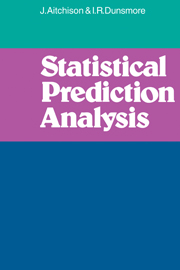Book contents
- Frontmatter
- Contents
- Preface
- 1 Introduction
- 2 Predictive distributions
- 3 Decisive prediction
- 4 Informative prediction
- 5 Mean coverage tolerance prediction
- 6 Guaranteed coverage tolerance prediction
- 7 Other approaches to prediction
- 8 Sampling inspection
- 9 Regulation and optimisation
- 10 Calibration
- 11 Diagnosis
- 12 Treatment allocation
- Appendix I
- Appendix II
- Bibliography
- Author index
- Subject index
- Example and problem index
12 - Treatment allocation
Published online by Cambridge University Press: 12 October 2009
- Frontmatter
- Contents
- Preface
- 1 Introduction
- 2 Predictive distributions
- 3 Decisive prediction
- 4 Informative prediction
- 5 Mean coverage tolerance prediction
- 6 Guaranteed coverage tolerance prediction
- 7 Other approaches to prediction
- 8 Sampling inspection
- 9 Regulation and optimisation
- 10 Calibration
- 11 Diagnosis
- 12 Treatment allocation
- Appendix I
- Appendix II
- Bibliography
- Author index
- Subject index
- Example and problem index
Summary
The nature of a treatment allocation problem
When a treatment is applied to an object or individual it is with the express purpose of altering the future of that object or individual. Thus when we choose one of a number of possible refining processes for a batch of raw material we intend that the batch will in the future attain some desirable quality. When we select a method of machining an industrial component we have in mind some future characteristic of the component. When we prescribe a particular treatment for a patient we hope that some specific aspect of his future condition will be more agreeable than his present state of disease. Because of this preoccupation with the future state of an object or individual it will not be surprising to find that statistical prediction analysis has an important role to play in the problem of treatment allocation.
In the examples already mentioned there are three basic sets which must clearly play an important role. First we suppose that the present state or indicator t of the individual unit under consideration belongs to some specifiable set T of possible initial states or indicators. Secondly, there is some set A of possible treatments from which we have to select a treatment a to apply to the individual unit. Thirdly we must to some extent assess the effectiveness of treatment in terms of the future state or response y attained by the unit after application of treatment; we thus have to be in a position to envisage the set Y of possible future states or responses.
- Type
- Chapter
- Information
- Statistical Prediction Analysis , pp. 238 - 248Publisher: Cambridge University PressPrint publication year: 1975



